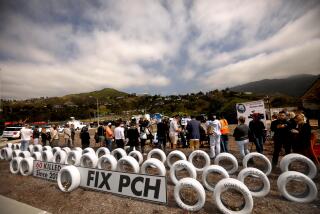Promoting an Inflated Sense of Safety
- Share via
Pumped up about traveling this Memorial Day? Keep an eye open for the new public service campaign that state attorneys general and consumer protection offices launched nationwide Monday. The Safe Tires Campaign will debut this weekend with TV and radio spots, print ads and its own Web site (www.safetrip.org) promoting proper tire maintenance. It will continue during the other two peak summer travel holidays, the Fourth of July and Labor Day.
“The basic message is very simple: Take care of your tires, and they will take care of you,” says Tennessee Atty. Gen. Paul Summers, chairman of the Safe Trip Campaign.
What’s of particular interest to consumers about this educational campaign, besides its tire-care pointers, is that the effort is entirely bankrolled from the $51.5-million Bridgestone/Firestone settlement forged last November. The giant tire company not only agreed to pay off states’ lawsuits over defective tires and its misrepresentations in promoting and replacing those tires, but also to ante up $5 million for a tire safety awareness program.
“As a result of the Bridgestone/Firestone case, we learned a lot of things about tire inflation,” says Summers, adding that just as tire manufacturers must take responsibility for making sound products, the public needs to take responsibility for maintaining them. Tire pressure should be checked once a month.
The National Highway Traffic Safety Administration estimates that proper tire inflation alone could save 50 to 80 lives and prevent 6,600 to 10,600 injuries each year. “Seriously underinflated or overinflated tires, even on a well-made tire, can be hazardous to your health,” says Summers. “Add heat and overloading and you have exacerbated the problem. And that results in blowouts, deterioration of the tire, injury or death.”
Among the campaign’s recommendations:
* Use a tire-pressure gauge, available for as little as $3 to $5, to ensure tires are properly inflated.
* For the most accurate reading, check pressure when tires are cool.
* Use the automaker’s recommended tire pressure--usually printed on a placard in the doorjamb, inside the fuel-filler door, inside the glove compartment door or in the owner’s manual.
* Perform a monthly tread check: Stick a penny in the grooves of your tire with Lincoln’s head toward the tread. If you can see the top of Lincoln’s head from the side, you need new tires.






